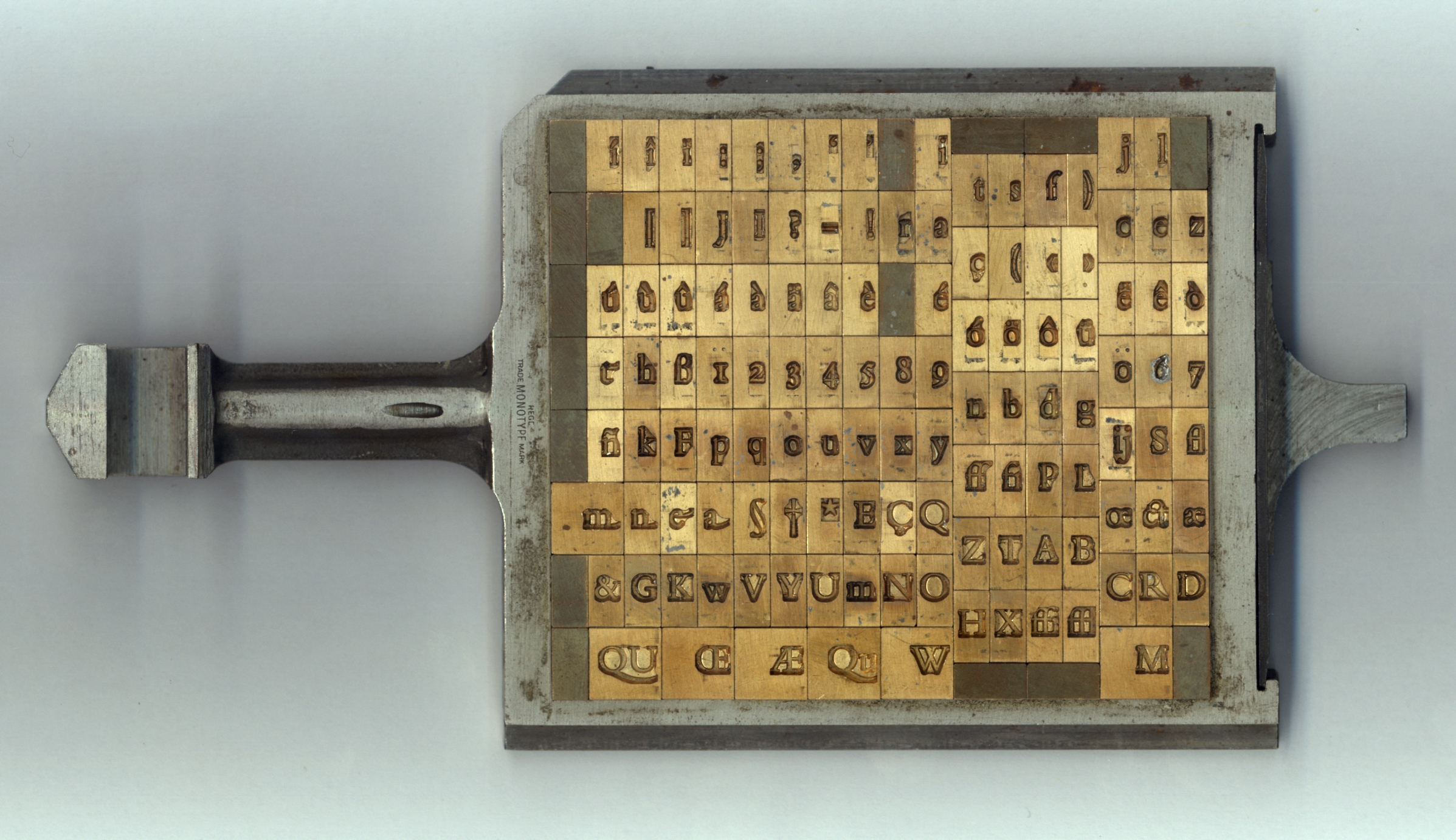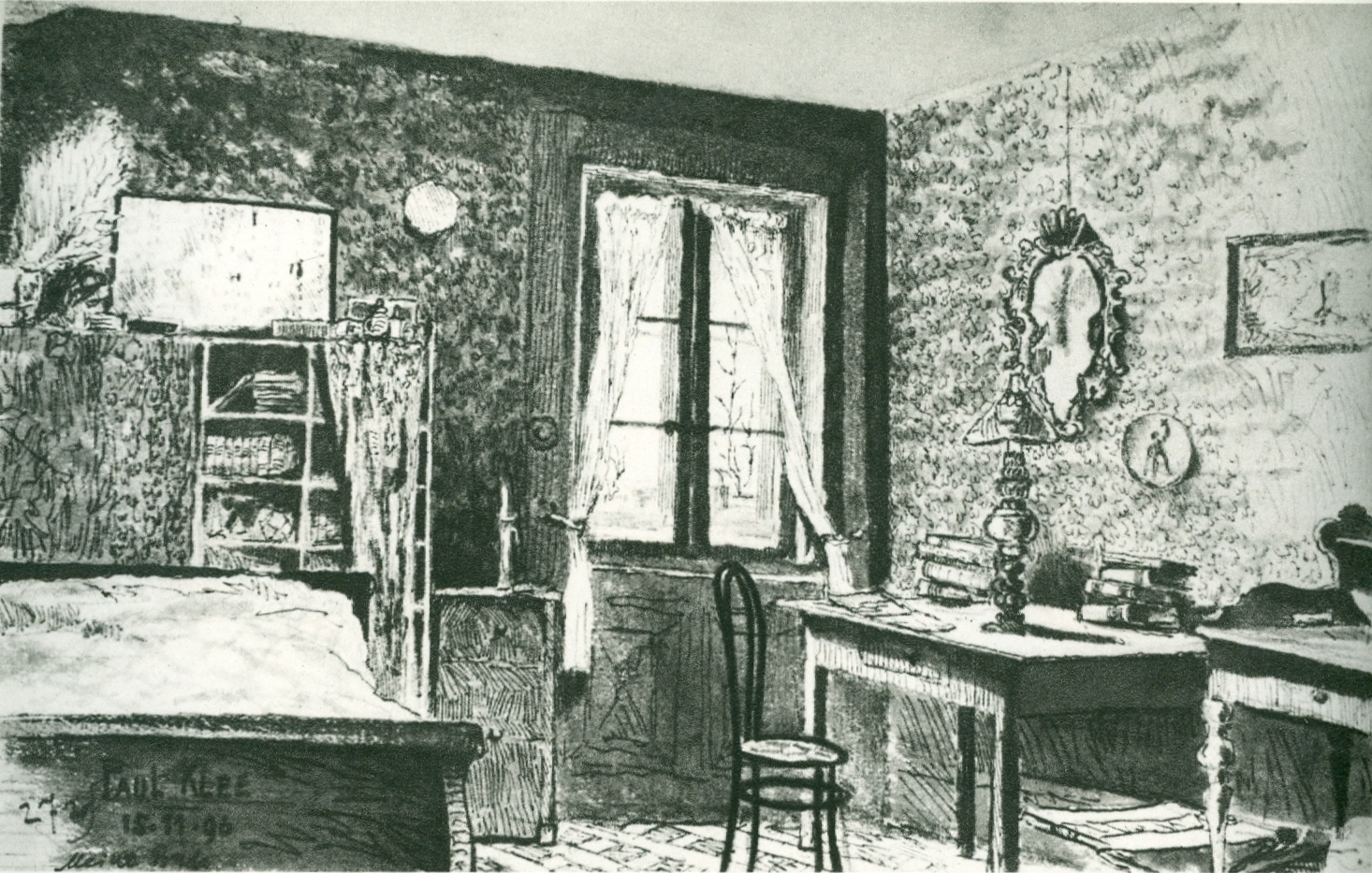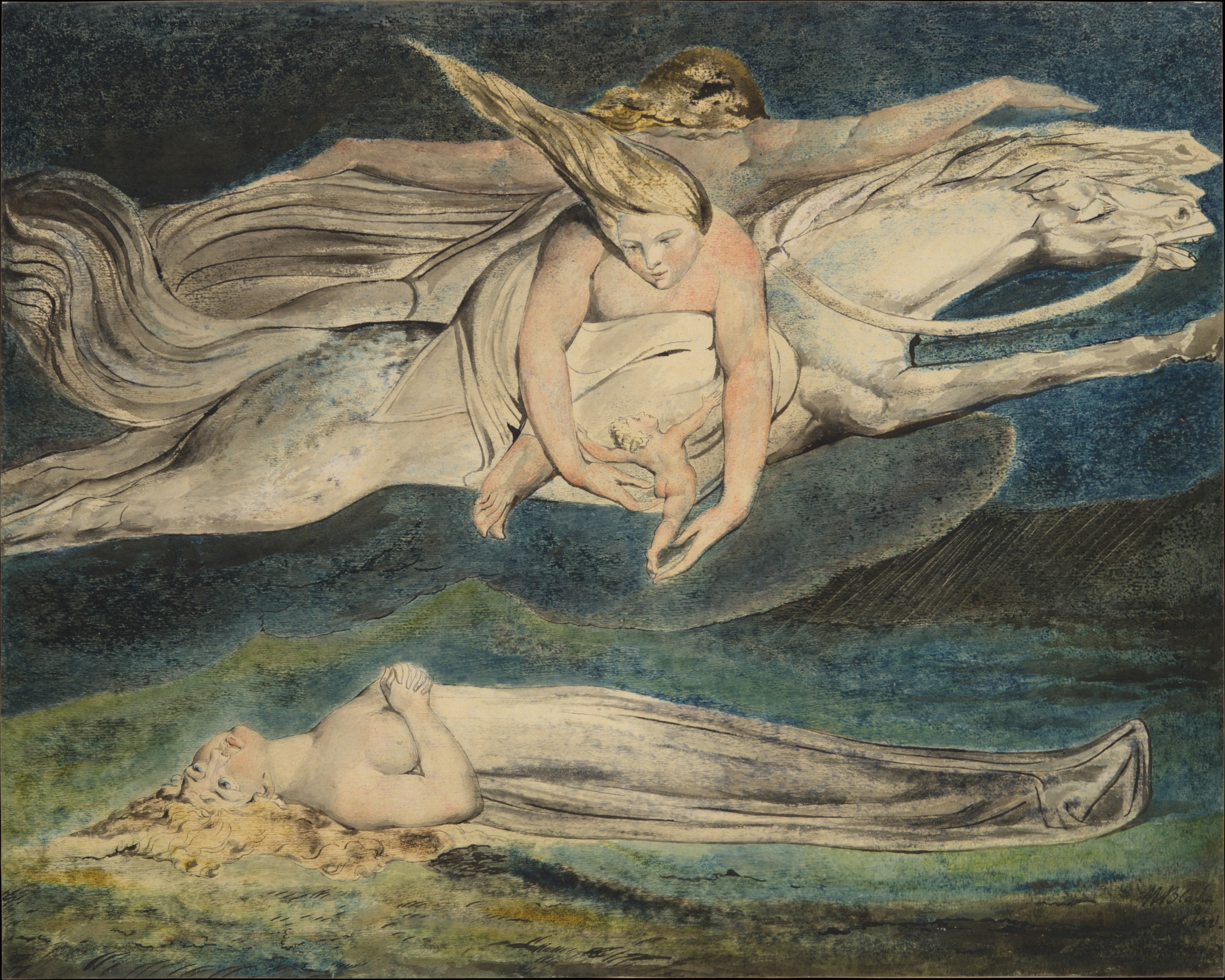|
Monotype
Monotyping is a type of printmaking made by drawing or painting on a smooth, non-absorbent surface. The surface, or matrix, was historically a copper etching plate, but in contemporary work it can vary from zinc or glass to acrylic glass. The image is then transferred onto a paper by pressing the two together, using a printing-press, brayer, baren or by techniques such as rubbing with the back of a wooden spoon or the fingers which allow pressure to be controlled selectively. Monotypes can also be created by inking an entire surface and then, using brushes or rags, removing ink to create a subtractive image, e.g. creating lights from a field of opaque colour. The inks used may be oil or water-based. With oil-based inks, the paper may be dry, in which case the image has more contrast, or the paper may be damp, in which case the image has a 10 percent greater range of tones. Monotyping produces a unique print, or monotype; most of the ink is removed during the initial pressing. ... [...More Info...] [...Related Items...] OR: [Wikipedia] [Google] [Baidu] |
Antoon Sallaert
Antoon Sallaert or Anthonis Sallaert (1594–1650) was a Flemish Baroque painter, draughtsman and printmaker who was active in Brussels. Sallaert produced many devotional paintings for the Brussels court of Archdukes Albert and Isabella as well as for the local churches. Sallaert was an innovative printmaker and is credited with the invention of the monotype technique. He was an important tapestry designer for the local weaving workshops.Hans Vlieghe. "Sallaert, Anthonis." Grove Art Online. Oxford Art Online. Oxford University Press. Web. 10 March 2016 Life Antoon Sallaert was a pupil of the Brussels painter Michel de Bordeaux starting from 1606. He was registered as a master in the Brussels Guild of Saint Luke in 1613.Antoine Sallaert at [...More Info...] [...Related Items...] OR: [Wikipedia] [Google] [Baidu] |
Paul Gauguin
Eugène Henri Paul Gauguin (, ; ; 7 June 1848 – 8 May 1903) was a French Post-Impressionist artist. Unappreciated until after his death, Gauguin is now recognized for his experimental use of colour and Synthetist style that were distinct from Impressionism. Toward the end of his life, he spent ten years in French Polynesia. The paintings from this time depict people or landscapes from that region. His work was influential on the French avant-garde and many modern artists, such as Pablo Picasso and Henri Matisse, and he is well known for his relationship with Vincent and Theo van Gogh. Gauguin's art became popular after his death, partially from the efforts of dealer Ambroise Vollard, who organized exhibitions of his work late in his career and assisted in organizing two important posthumous exhibitions in Paris. Gauguin was an important figure in the Symbolist movement as a painter, sculptor, printmaker, ceramist, and writer. His expression of the inherent meaning of t ... [...More Info...] [...Related Items...] OR: [Wikipedia] [Google] [Baidu] |
Printmaking
Printmaking is the process of creating artworks by printing, normally on paper, but also on fabric, wood, metal, and other surfaces. "Traditional printmaking" normally covers only the process of creating prints using a hand processed technique, rather than a photographic reproduction of a visual artwork which would be printed using an electronic machine ( a printer); however, there is some cross-over between traditional and digital printmaking, including risograph. Except in the case of monotyping, all printmaking processes have the capacity to produce identical multiples of the same artwork, which is called a print. Each print produced is considered an "original" work of art, and is correctly referred to as an "impression", not a "copy" (that means a different print copying the first, common in early printmaking). However, impressions can vary considerably, whether intentionally or not. Master printmakers are technicians who are capable of printing identical "impressions" ... [...More Info...] [...Related Items...] OR: [Wikipedia] [Google] [Baidu] |
Degas
Edgar Degas (, ; born Hilaire-Germain-Edgar De Gas, ; 19 July 183427 September 1917) was a French Impressionist artist famous for his pastel drawings and oil paintings. Degas also produced bronze sculptures, prints and drawings. Degas is especially identified with the subject of dance; more than half of his works depict dancers. Although Degas is regarded as one of the founders of Impressionism, he rejected the term, preferring to be called a realist,Gordon and Forge 1988, p. 31 and did not paint outdoors as many Impressionists did. Degas was a superb draftsman, and particularly masterly in depicting movement, as can be seen in his rendition of dancers and bathing female nudes. In addition to ballet dancers and bathing women, Degas painted racehorses and racing jockeys, as well as portraits. His portraits are notable for their psychological complexity and their portrayal of human isolation. At the beginning of his career, Degas wanted to be a history painter, a calling for ... [...More Info...] [...Related Items...] OR: [Wikipedia] [Google] [Baidu] |
Matrix (printing)
In the manufacture of metal type used in letterpress printing, a matrix (from the Latin meaning ''womb'' or ''a female breeding animal'') is the mould used to cast a letter, known as a sort. Matrices for printing types were made of copper. However, in printmaking the matrix is whatever is used, with ink, to hold the image that makes up the print, whether a plate in etching and engraving or a woodblock in woodcut. Description In letterpress or "cold metal" typesetting, used from the beginning of printing to the late nineteenth century, the matrix of one letter is inserted into the bottom of an adjustable-width hand mould, the mould is locked and molten type metal is poured into a straight-sided vertical cavity above the matrix. When the metal has cooled and solidified the mould is unlocked and the newly cast metal sort is removed. The matrix can then be reused to produce more copies of the sort.Meggs, Philip B. ''A History of Graphic Design.'' John Wiley & Sons, Inc. 1998. (pp ... [...More Info...] [...Related Items...] OR: [Wikipedia] [Google] [Baidu] |
Giovanni Benedetto Castiglione
Giovanni Benedetto Castiglione (baptized 23 March 16095 May 1664) was an Italian Baroque painter, printmaker and draftsman, of the Genoese school. He is best known now for his etchings, and as the inventor of the printmaking technique of monotyping. He was known as ''Il Grechetto'' in Italy and in France as ''Le Benédette''. Biography Castiglione was born in Genoa. The biographer of Genoese painters, Raffaele Soprani says his parents had him places in the studio of Giovanni Battista Paggi. Wittkower describes him as a "passionate student" of Anthony van Dyck, who arrived in 1621, and Peter Paul Rubens, who stayed in the city in the first decade of the 17th century and whose paintings were readily accessible there. He may have trained under the Genoese Bernardo Strozzi. He lived in Rome from 1634 to about 1645, then returned to Genoa. He also traveled to Florence and Naples. He was back in Rome in 1647, before moving in 1651 to be a court artist in Mantua for Duke Carlo II ... [...More Info...] [...Related Items...] OR: [Wikipedia] [Google] [Baidu] |
Nicole Eisenman
Nicole Eisenman (born 1965) is French-born American artist known for her oil paintings and sculptures. She has been awarded the Guggenheim Fellowship (1996), the Carnegie Prize (2013), and has thrice been included in the Whitney Biennial (1995, 2012, 2019). On September 29, 2015, she won a MacArthur Fellowship award for "restoring the representation of the human form a cultural significance that had waned during the ascendancy of abstraction in the 20th century." Eisenman lives in Brooklyn. Biography Nicole Eisenman was born in 1965 in Verdun, France where her father was stationed as an army psychiatrist. She is of German-Jewish descent; her great-grandmother was Esther Hamerman, a Polish-born painter. In 1970, Eisenman's family moved from France to Scarsdale, New York, where she spent her childhood. [...More Info...] [...Related Items...] OR: [Wikipedia] [Google] [Baidu] |
Paul Klee
Paul Klee (; 18 December 1879 – 29 June 1940) was a Swiss-born German artist. His highly individual style was influenced by movements in art that included expressionism, cubism, and surrealism. Klee was a natural draftsman who experimented with and eventually deeply explored color theory, writing about it extensively; his lectures ''Writings on Form and Design Theory'' (''Schriften zur Form und Gestaltungslehre''), published in English as the '' Paul Klee Notebooks'', are held to be as important for modern art as Leonardo da Vinci's '' A Treatise on Painting'' was for the Renaissance. He and his colleague, Russian painter Wassily Kandinsky, both taught at the Bauhaus school of art, design and architecture in Germany. His works reflect his dry humor and his sometimes childlike perspective, his personal moods and beliefs, and his musicality. Early life and training Paul Klee was born in Münchenbuchsee, Switzerland, as the second child of German music teacher Hans Wilhe ... [...More Info...] [...Related Items...] OR: [Wikipedia] [Google] [Baidu] |
Pissarro
Jacob Abraham Camille Pissarro ( , ; 10 July 1830 – 13 November 1903) was a Danish-French Impressionist and Neo-Impressionist painter born on the island of St Thomas (now in the US Virgin Islands, but then in the Danish West Indies). His importance resides in his contributions to both Impressionism and Post-Impressionism. Pissarro studied from great forerunners, including Gustave Courbet and Jean-Baptiste-Camille Corot. He later studied and worked alongside Georges Seurat and Paul Signac when he took on the Neo-Impressionist style at the age of 54. In 1873 he helped establish a collective society of fifteen aspiring artists, becoming the "pivotal" figure in holding the group together and encouraging the other members. Art historian John Rewald called Pissarro the "dean of the Impressionist painters", not only because he was the oldest of the group, but also "by virtue of his wisdom and his balanced, kind, and warmhearted personality". Paul Cézanne said "he was a ... [...More Info...] [...Related Items...] OR: [Wikipedia] [Google] [Baidu] |
Pity (William Blake)
''Pity'' (c. 1795) is a colour print on paper, finished in ink and watercolour, by the English artist and poet William Blake, one of the group known as the "Large Colour Prints". Along with his other works of this period, it was influenced by the Bible, Milton, and Shakespeare. The work is unusual, as it is a literal illustration of a double simile from ''Macbeth'', found in the lines: :And pity, like a naked new-born babe, :Striding the blast, or heaven's cherubim, hors'd :Upon the sightless couriers of the air. :- ''Macbeth'' (1.7.21–23) Like other members of the group it is a monotype produced by printing from a matrix consisting of paint on gessoed millboard, with each impression then finished by hand. By this unusual means Blake could obtain up to three impressions from a single painting. Three such impressions survive of ''Pity''. A fourth, in the British Museum, was an early trial of the design from a different matrix, as it is smaller than the others. Interpreta ... [...More Info...] [...Related Items...] OR: [Wikipedia] [Google] [Baidu] |
Chiaroscuro
Chiaroscuro ( , ; ), in art, is the use of strong contrast (vision), contrasts between light and dark, usually bold contrasts affecting a whole composition. It is also a technical term used by artists and art historians for the use of contrasts of light to achieve a sense of volume in modelling three-dimensional objects and figures. Similar effects in cinema, and black and white and low-key photography, are also called chiaroscuro. Further specialized uses of the term include chiaroscuro woodcut for coloured woodcuts printed with different blocks, each using a different coloured ink; and chiaroscuro drawing for drawings on coloured paper in a dark medium with white highlighting. Chiaroscuro is one of the canonical painting modes of the Renaissance (alongside cangiante, sfumato and unione) (see also Renaissance art). Artists known for using the technique include Leonardo da Vinci, Caravaggio Rembrandt, Johannes Vermeer, Vermeer and Francisco Goya, Goya, and Georges de La Tour. ... [...More Info...] [...Related Items...] OR: [Wikipedia] [Google] [Baidu] |
Watercolor
Watercolor (American English) or watercolour (British English; see spelling differences), also ''aquarelle'' (; from Italian diminutive of Latin ''aqua'' "water"), is a painting method”Watercolor may be as old as art itself, going back to the Stone Age when early ancestors combined earth and charcoal with water to create the first wet-on-dry picture on a cave wall." London, Vladimir. The Book on Watercolor (p. 19). in which the paints are made of pigments suspended in a water-based solution. ''Watercolor'' refers to both the medium and the resulting artwork. Aquarelles painted with water-soluble colored ink instead of modern water colors are called ''aquarellum atramento'' (Latin for "aquarelle made with ink") by experts. However, this term has now tended to pass out of use. The conventional and most common ''support''—material to which the paint is applied—for watercolor paintings is watercolor paper. Other supports or substrates include stone, ivory, silk, reed, ... [...More Info...] [...Related Items...] OR: [Wikipedia] [Google] [Baidu] |

_-_Crucifixion_of_St_Peter.jpg)


.jpg)







